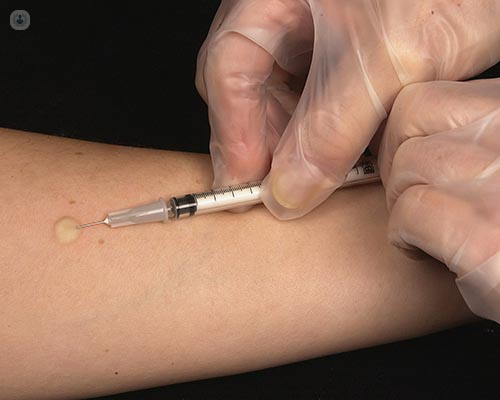Tuberculosis (TB) skin tests
What is being analysed?
The Tuberculosis (TB) skin test, also known as the Mantoux test or tuberculin sensitivity test, analyses the body's immune response to the bacterium that causes tuberculosis.

What does the result mean?
The result indicates whether a person has been infected with the tuberculosis bacterium. A positive result means that the person has been exposed to TB bacteria, but it does not necessarily mean they have active tuberculosis. A negative result indicates that the person has not reacted to the TB antigens injected into the skin.
Why do the analysis?
The analysis is performed to detect latent tuberculosis infection (LTBI) or to assess the risk of active tuberculosis disease. It helps in early detection and treatment, reducing the risk of spreading TB to others.
When to do the analysis?
The TB skin test is typically done if a person has been in close contact with someone with active TB, if they have symptoms of TB, if they are at high risk for TB infection due to certain medical conditions or occupations, or as part of routine screening in high-risk populations.
What sample is required?
The test requires a small amount of tuberculin purified protein derivative (PPD) to be injected into the forearm of the patient.
Is any type of prior preparation necessary?
No special preparation is needed before the TB skin test. However, individuals should inform their doctor about any medications they are taking, as certain medications can affect the accuracy of the test.
How is it used?
The TB skin test measures the size of the induration (hard, raised area) that develops at the injection site within 48 to 72 hours after the test. A specialist examines the injection site and measures the induration using a ruler.
What are the normal values?
Normal values for the TB skin test depend on the individual's risk factors and can vary by population and country guidelines. Generally, an induration of 5 mm or larger is considered positive in certain high-risk groups, while an induration of 10 mm or larger is considered positive in most other individuals.
What does it mean to have altered values?
Altered values, such as a positive result, indicate exposure to the TB bacterium. Further evaluation, including chest X-rays and sputum tests, may be needed to confirm active tuberculosis disease. A negative result does not rule out TB infection, especially in individuals with weakened immune systems.
Table of normal values for Tuberculosis (TB) Skin Test
|
Risk Group |
Normal Value |
|
High-risk groups* |
≥ 5 mm induration |
|
General population |
≥ 10 mm induration |
*High-risk groups include individuals with HIV/AIDS, recent TB contacts, recent immigrants from high-prevalence countries, and those with certain medical conditions or occupations.
This test helps in the early detection of tuberculosis infection, aiding in prompt treatment and prevention of further transmission.




